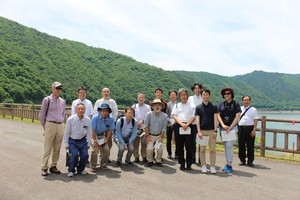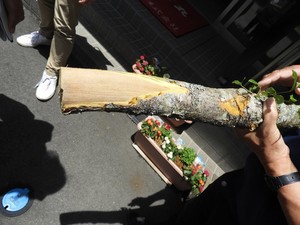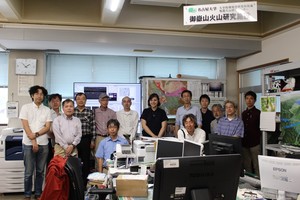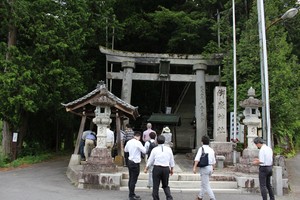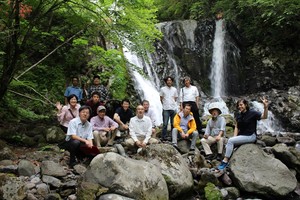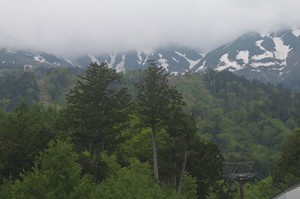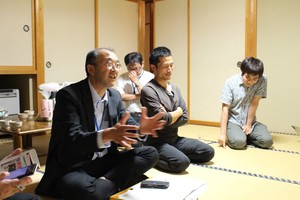Home![]() Clinical Environmental Studies Program
Clinical Environmental Studies Program![]() On-site Research Training(ORT)/SDGs basic seminar
On-site Research Training(ORT)/SDGs basic seminar![]() 【2/3】Report on On-site Research Training (ORT) at Kiso Town, Nagano
【2/3】Report on On-site Research Training (ORT) at Kiso Town, Nagano
Clinical Environmental Studies Program
2019-07-01 【2/3】Report on On-site Research Training (ORT) at Kiso Town, Nagano
June 14th - Kiso Town and Otaki Village
1. Forest Museum
As far as I understood, this museum established at the former forestry high school building around 5 years ago by Nagano prefecture government. However, the museum is supported financially only by the forestry graduates association. Teaching forestry at Kiso town dates back to the Meiji era, and the gentleman who was explaining to us about the museum used to be a teacher at the forestry school. At the moment 10 volunteers are in charge of the management of the museum whose average age is 76 years old. According to what he mentioned, the goal of establishing such museum is telling the history of forestry education, and it really fulfilled such goal as he guided us step by step through every single part of the museum explaining enthusiastically like a story.
He explained how Hinoki forests attracted so many researchers to Kiso town at the end of the Meiji era. He talked about the famous professor Honda and his contribution to forestry education, and the importance of field observation in this major. The museum also had a specific place for lacquer painting and taxidermy, and a library. According to our guide, not so many people visit the museum; children specifically do not have any interests.
In my opinion, one of the most amazing parts of the museum was the equipment gallery and also the models that students made showing how they used to transport the logs. It is also noteworthy that the museum is only open 1 day during weekdays.
2. Makio Dam
According to the information on the dam card, Makio dam is a rock fill dam with a capacity of 75,000,000 m3 completed in 1961 as a supply for agriculture, industrial, and domestic use, and also hydroelectric power generation. According to the graph provided by the gentleman who was explaining for us, the amount of stored water in the dam at the moment is at the lowest rank during the past 5 years (on June 14th the used capacity of the dam was only 32.2%). Water usage restriction is usually applied to agriculture (the largest consumer).
Our guide also mentioned about the sedimentation issue and the decreased quality of sediments after 2014 eruption. Apparently, sediments had commercial value as construction material before 2014. However, now a large amount of money needs to be paid for sedimentation transfer, and probably dredging will be a necessity in the near future.
3. Hyakusou - Nagano Prefecture Pharmaceutical, Otaki Village
"Hyakusou" literally means 100 herbs and it is a kind of herbal medicine with a history stretching back to the Edo period. Unlike what the name suggests it is made of 5 different herbs, the most important of which is the extract of the bark of Kihada tree (Cork tree). This tree was previously imported from China. However, at the moment the amount of imported material has been decreased considerably. During the visit, our guide explained the whole procedure from raw material to the final product. He mentioned the necessity of a clean environment for producing quality medicine and that is why most of the pharmaceutical companies are located in the countryside. We also had the chance to observe so many herbs, flowers, mushrooms, oyster shells, dried animals or even horns with medical applications.
He mentioned two major issues regarding this business: 1) young people having no interest to work in agriculture 2) expensive human resources in Japan.
He also said that around 1000-2000 people visit this factory annually. Also, they had a specific lab for testing new products.
4. Lunch at hotel "Sanyoukan"
Lunch was served at a hotel close to the volcano research center.
5. Earthquake and Volcano Research Center
According to Takahiro sensei, this Kiso town's observatory has been launched in 2017. The aims of this center are:
Raising the ability to predict volcano activity
-
Disaster mitigation
-
Educating local people about volcano activity, disaster mitigation and fostering human resources
2014 eruption was a misfortunate event since it happened in autumn during the weekend and at noon when a lot of people climbing Ontake-san. At that time no information about the volcano activity was provided for the climbers and they themselves were not aware of the threats of an active volcano. In order to overcome such issues, the data (from Japan meteorological agency and researchers) should be disseminated to climbers and local people.
There was a big screen at the research center showing real-time seismic data which could be used for predicting probable volcanic activity. I also asked about the number of climbers before and after 2014 eruption. Apparently, after 2014, mount Ontake was closed to climbers for 3 years, and last year it was opened only for a limited time (2-3 weeks) during which 9600 people climbed Ontake-san (only around 2000 climbed to the summit). Before 2014, the number of climbers was around 3 times the last year's number. Takahiro sensei also wanted to show us a real simulation of a volcano eruption. However, due to the intensive schedule and limited time we could not watch it this time.
6. Mitake Shrine
Before hearing the talk of Takei san at the shrine, we climbed so many stairs to reach another shrine which was located at the beginning of one of the trails to Ontake-san summit. It had such a mysterious feeling standing there in the middle of abundant trees knowing that there was a time when ordinary people were not allowed to climb a sacred mountain like Ontake-san.
After this short visit, we had a meeting at the shrine where Takei san explained to us about the "Ontake-Kyo" religion and its spread in the Edo period. Apparently, until the end of the Edo era, only a limited number of people could climb Ontake-san. However, little by little more people showed interest in such activities. According to Takei san, there was a shrine at the summit of Ontake-san. Although some parts of it were destroyed during 2014 eruption, this August it will be repaired completely.
Mitake religion headquarter is located in Nara. Takei san also talked about the spirit faith (Reijin Shinkoo).
7. Ontake and Waterfalls
After visiting the shrine, it was time to search for the relation between religion and nature. We approached Ontake-san by car and then started exploring it on foot. On our way, we saw a lot of big stones sitting close to each other (like a graveyard) at the foot of the mountain (probably related to Reijin Shinkoo). During this visit, we could see 3 beautiful waterfalls and it was such a refreshing experience.
8. Ontake Ropeway
The last visit of the second day was Ontake ropeway. At the time of our visit it was not operating (working period: June 22nd -Nov. 4th). However, we were so close to mount Ontake and it was very exciting. On our way to the ropeway station, we also saw wild monkeys which was an interesting experience.
9. Interviews with Local People at "Izumi" Guesthouse
After check-in at the guesthouse "Izumi", we got prepared for dinner and the interview session. Apart from Mr. Ito and Mr. Miyoshi, we had 3 other guests (Mr. Kimura and Mr. Hattori both as local vitalization cooperators, and Mr. Oome from the group of regional construction).
Kimura san came to Kiso town 4 years ago (just after the eruption) as a local vitalization cooperator and lived in Kiso-Fukushima for a while, but then moved to Kaida. During these years, he realized that there is no so many accommodations for outsiders who want to live in Kaida; there are houses to sell but not for rent which is a big issue. He also mentioned how local people of Kaida are shy but they open up when there is a chance for cooperation. He also has plans to invest in generating hydroelectric power to make strong connections with local people.
Hattori san just came to Kiso town on this April. His grandfather had a second house in Kaida, so he was familiar with this area and was worried about the decreasing number of tourists. He has studied Ecology Economics at the university and he is interested in managing "Satoyama". He is working part-time in Ontake health lab and also Yamayuriso guesthouse. His vision is promoting health activities in this area and joining it to other facilities like guesthouses for skiers.
Oome san was born in Kaida. He used to be an officer and now he is a member of the town parliament. He mentioned some of the problems of Kiso town namely decreasing population, young people leaving for urban areas and the limited number of students. He also talked about an event he organized last year in Nagoya for selling Kiso town local food (searching for a market in big cities). He also talked about the beautiful landscape of Kaida and the preservation regulations. In his opinion, Kaida (at least at the time of economic growth) brought ski and golf to mind. Oome san believed that outsiders specifically I-turners can bring a new perspective and new resources to areas like Kaida.
We also talked about the possibility of making the connection between Kaida and Takane in Takayama stronger in order to address the problem of limited students for specific levels of education and also for bringing more tourists to Kaida promoting the local economy as well. However, one of the problems associated with Kaida is the geographic location and the fact that you cannot enjoy exploring it on foot (you need a car).

